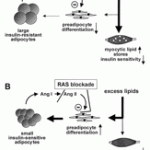Hindsight: Angiotensin Blockade Prevents Type 2 Diabetes By Formation of Fat Cells?
Saturday, May 19, 2012 Readers may recall last week’s Hindsight post on our paper in which we described our finding that angiotensin II inhibits the adipogenic differentiation of fat cells, and conversely, blocking the AT 1 receptor resulted in an accelerated differentiation of adipocyte precursor cells.
Readers may recall last week’s Hindsight post on our paper in which we described our finding that angiotensin II inhibits the adipogenic differentiation of fat cells, and conversely, blocking the AT 1 receptor resulted in an accelerated differentiation of adipocyte precursor cells.
While many would think that growing more fat cells may be a bad thing, it is important to remember that in a state of positive energy balance, the best place to store those extra calories is indeed in your fat tissue. Not being able to expand your fat tissue to accommodate excess calories may lead to the deposition of the extra fat in other tissues, which in turn, may prompt many of the metabolic problems associated with excess weight.
This, at least, was the main tenor of a ‘hypothesis’ paper, we published in HYPERTENSION in 2002, in which we proposed the notion that blockade of the renin-angiotensin system may prevent the development of diabetes by promoting the recruitment and differentiation of adipocytes.
This was based on our reasoning that the increased formation of adipocytes would counteract the ectopic deposition of lipids in other tissues (muscle, liver, pancreas), thereby improving insulin sensitivity and preventing the development of type 2 diabetes.
Interestingly enough, this mechanism of diabetes prevention and treatment was harnessed by the use of thiazolidinediones also known as glitazones, a class of medications used in the treatment of type 2 diabetes.
According to Google Scholar, this paper has been cited 257 times.
AMS
Edmonton, Alberta


